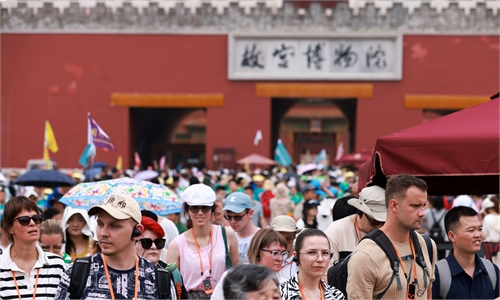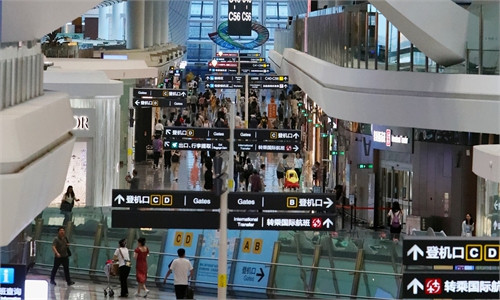China’s inbound tourism sees huge surge in first 7 months, backed by new measures
Foreigners entering China up 130% from Jan-Jul, as door opens wider

Tourists from New Zealand practice tai chi in Shiyan, Hubei Province. Photo: Xi'an Zhongheng International Travel Agency
China has intensified efforts to make it easier for foreigners to come to China, and positive results have been observed, officials from the National Immigration Administration (NIA) said on Monday, as the nation is increasingly opening its door wider to the outside world.
Speaking at a press conference held by the State Council Information Office, Liu Haitao, a senior official of the NIA, told reporters that from January to July, there were 17.254 million entries by foreign nationals at various domestic ports, a year-on-year increase of 129.9 percent. The number of port visas issued reached 846,000, up 182.9 percent.
Officials and industry analysts attributed the growth to policy measures, including the 144-hour visa-free transit policy, which simplifies travel for foreigners. There will be more foreigners coming to China for travel, study or work, as more new policy benefits are unleashed, experts said.
"The significant increase in inbound visitors from January to July was mainly due to visa facilitation... Additionally, China's appeal to foreign tourists is continuously rising, with its vast territory, and rich natural and cultural resources, in conjunction with the policy support," Zhang Lingyun, executive editor-in-chief of Tourism Tribune magazine, told the Global Times on Monday, adding that China also remains a safer travel destination compared with some other countries and regions.
The substantial growth in inbound tourism was also attributable to ongoing policy optimization, reflecting China's determination and confidence in its opening-up to the outside world, Zhang said.
Specifically, improvements have been made in visa issuance, visa-free transit policies, border crossing procedures and payment facilitation, the expert said.
In recent years, the NIA has expanded the range of visa-free countries in collaboration with relevant departments and introduced measures to facilitate foreign visitors coming to China.
Liu highlighted the popular 144-hour visa-free transit policy, which "now applies to 37 ports and 54 countries." This reflects the high level of opening-up and high-quality development of China's immigration management services.
Citizens from the 54 countries including the US, Canada and the UK who enter China through the designated entry ports and who hold valid international travel documents and connecting tickets to a third country within 144 hours, are allowed to stay in designated areas for tourism, business or visiting relatives, according to the policy.
The visa-free transit policy, which has further shown its advantages this year, has become a "key to attracting tourists" and "policy hallmark" of China's expanding opening-up, Liu said.
Additionally, the NIA has introduced various new policies, including 144-hour visa-free entry for foreign tour groups from Hong Kong and Macao special administrative regions into South China's Guangdong Province; 144-hour visa-free entry for tour groups from the ASEAN countries into Guilin, South China's Guangxi Zhuang Autonomous Region; 30-day visa-free entry for nationals from 59 countries into South China's Hainan Province, and 15-day visa-free entry for foreign tour groups arriving by cruise ships in coastal provinces.
The policy has also been extended to include 144-hour visa-free entry for foreign tour groups from Hong Kong and Macao into Hainan, benefiting more than 5.9 million foreign visitors, according to the NIA.
The NIA has further relaxed visa application conditions at domestic ports. Foreigners who need to come to China for business, visits or other activities can now apply for port visas at 100 visa offices across 73 cities, Liu said.
The combined effect of these policies has led to a rapid increase in the number of foreign visitors coming to China, boosting the inbound tourism market.
According to the National Bureau of Statistics, the average daily expenditure of foreign tourists in China amounted to 3,459 yuan ($484.43) in 2023, directly driving up consumption by more than 100 billion yuan.
The surge in inbound travel is closely related to the government's determination to develop the inbound tourism industry, which is still in a recovery mode in the aftermath of the COVID-19 pandemic, Yang Jinsong, a senior expert with the China Tourism Academy, told the Global Times on Monday.
The continuous improvement in tourism, as well as people-to-people exchanges between the Chinese mainland and Hong Kong and Macao, have been important drivers, Yang said, indicating that a significant portion of inbound tourists come from the two special administrative regions, as the integrated development of the entire region is strengthened.
As there may be delays in policy implementation, the impacts will become more apparent in the second half of the year as more benefits of the policies are unleashed, experts said.
"It is expected that the inbound tourism market will continue to improve in the second half of the year, potentially reaching new highs since the pandemic," Yang said.



